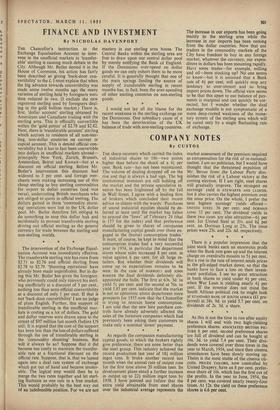FINANCE AND INVESTMENT
By NICHOLAS DAVENPORT THE Chancellor's instruction to the Exchange Equalisation Account to inter- vene in the unofficial markets in 'transfer- able' sterling is causing much debate in the City. Although Mr. Butler denied it in the House of Commons, his action has fairly been described as giving 'back-door con- vertibility' to the £. I must explain that when. the big advance towards convertibility was made some twelve months ago the many varieties of sterling held by foreigners were then reduced to two. (I exclude the new registered sterling used by foreigners deal- ing in the gold bullion market.) There is, first, 'dollar account' sterling obtained by Americans and Canadians trading with the sterling area. This is officially convertible within the 'gold points' of $2.78 and $2.82. Next, there is 'transferable account' sterling which accrues to residents of all non-ster- ling, non-dollar countries on current or capital account. This is denied official con- vertibility but it has in fact been convertible into dollars in unofficial markets abroad— principally New York, Zurich, Brussels, Amsterdam, Beirut and Kuwait—but at a discount on official sterling. Before Mr. Butler's intervention this discount had widened to 3 per cent. and foreign mer- chants were making increasing use of this cheap sterling to buy sterling commodities for export to dollar countries (and vice versa), undercutting British merchants who are obliged to quote in official sterling. The dollars gained in these 'commodity shunt- ing' operations were lost to the UK dollar pool. Mr. Butler therefore felt obliged to do something to stop this dollar leak and incidentally to prevent transferable sterling driving out official sterling as the general currency for trade between the sterling and non-sterling worlds.
• •
The intervention of the Exchange Equal- isation Account was immediately effective. The transferable sterling rate has risen from $2.71 to $2.76 and official sterling from $2.78 to $2.79. 'Shunting operations' have already been made unprofitable. But in do- ing this Mr. Butler has given the foreigner, who previously could only convert his sterl- ing unofficially at a discount of 3 per cent., nothing less than semi-official convertibility at a discount of only 1 per cent. If that is not 'back .door convertibility' I am no judge of plain English. Further, this support of transferable sterling in the unofficial mar- kets is costing us a lot of dollars. The gold and dollar reserves were drawn upon to the extent of $97 million last month (before US aid). It is argued that the cost of support has been less than the loss of dollars suffered through the use of transferable sterling in the 'commodity shunting' business. But will it always be so? Suppose that it did become too costly to maintain the transfer- able rate at a fractional discount on the official rate. Suppose, that is, that we lapsed again into a dual rate system of exchange which got out of hand and became intoler- able. The logical step would then be to merge the two rates together and let sterl- ing fluctuate as one rate in a free market. This would probably be the best way out of an indefensible position. For we are not masters in our sterling area house. The Central Banks within the sterling area are free to draw upon our central dollar pool by merely notifying the Bank of England. If the Dominions over-spend on dollar goods we can only exhort them to be more careful. It is generally thought that one of the main springs feeding the source of supply of transferable sterling in recent months has, in fact, been the over-spending of other sterling countries on non-sterling goods.
I would not lay all the blame for the recent weakness in the sterling exchange on the Dominions. One subsidiary cause of It has been the deterioration of the UK balance of trade with non-sterling countries. The increase in our exports has been going mainly to the sterling area while the increase in our imports has been coming from the dollar countries. Now that our traders in the commodity markets of the City have freedom to buy in any foreign market, whatever the currency, our expen- diture in dollars has been mounting rapidly. Have some trades—for example, milling and oil—been stocking up? No one seems to know—but it is assumed that a Bank rate of 4-1 per cent, will quickly stop any tendency to over-import and so bring import prices down. The official view seems to be that this upset to our balance of pay- ments is marginal and can quickly be cor- rected, but 1 wonder whether the dual exchange muddle is not symptomatic of a more deep-rooted weakness of the mone tary system of the sterling area which will be cured only by a single fluctuating rate of exchange.










































 Previous page
Previous page